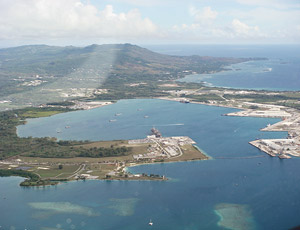The U.S. military’s multibillion-dollar program to build up facilities and infrastructure on the Pacific island of Guam to handle new troops could face scope and schedule changes, based on conclusions of the program’s final environmental review, released on July 28. But local officials on the island remain concerned about the military’s growing island footprint and impacts to cultural and ecological resources.

The military’s new facilities are needed to handle the transfer of thousands of Marines and other troops and dependents from the Japanese island of Okinawa, where they are now based, as well as an influx of construction and other workers.
The U.S. Navy’s final environmental impact statement (EIS) notes particular impacts “beyond the fence line” on the island’s already taxed infrastructure and housing stock, as well as its fragile natural resources. But Defense Dept. officials are expected to weigh in on a final “record of decision” by next month, as planned.
“I remain greatly concerned over the possibility that the Dept. of Defense will exceed its existing footprint in preparation for the relocation of US Marines,” said Michael W. Cruz, Guam’s lieutenant governor in an Aug. 6 letter to Navy Assistant Secretary Jackalyne Pfannenstiel. “Currently, DOD controls slightly more than a third of our island’s total landmass.”
A draft version of the review, released last fall, generated more than 10,500 comments. The EIS process for the Guam buildup, which is being managed by the Naval Facilities Engineering Command and will also include new and expanded Navy and Army facilities, was one of the largest reviews ever undertaken by the federal government, says Gen. David Bice, head of the Navy’s Joint Guam Program Office in Washington, DC.
Impacts on the island’s already stressed and aging water and wastewater infrastructure have been a particular target of concern of EIS commenters. Among them was Jared Blumenfeld, the U.S. Environmental Protection Agency’s regional administrator in San Francisco. In a letter to the Navy sent earlier this year commenting on the draft version of the EIS, he said the project’s “impacts are of sufficient magnitude that EPA believes the action should not proceed as proposed.” A regional spokesman for EPA says that Blumenfeld is still reviewing the final EIS and will submit new comments by the new 30-day deadline.
The final EIS estimates that wastewater upgrades alone on Guam could cost $1.3 billion over five years, including potential elevation of island treatment facilities to secondary level.
While the review says secondary treatment has not yet been mandated on Guam, it acknowledges that the overall cost figure for all upgrades is nearly double the roughly $740 million pledged by the government of Japan for all utility work, under an existing treaty between the U.S. and Japan signed to execute troop relocation from Okinawa.
DOD has signed pacts with local utilities for “cooperative use” of water resources on Guam, but financing approaches with the Japanese are still unclear and the island’s ability to meet EPA compliance mandates remains a “potential impediment” to the military relocation, says the EIS. It notes that discussions on securing additional federal funding sources are being facilitated at the White House level. The review also calls for the need to expand Guam’s limited road network. Up to 58 projects are outlined, including three new projects to rehabilitate deficient bridges.
The arrival of more than 46,300 workers on the island at peak construction in 2014 would require at least 9,000 new housing units, says the EIS. Noting local utilities’ technical and financial limits to handle the population surge, “the impacts of workforce housing...are assessed as significant,” says the review.
The Navy has opted to defer a decision on a specific location for construction of a new deep-water port in Apra Harbor for visiting nuclear aircraft carriers, with many critical responses focused on potential impacts to coral and natural resources of the significant dredging to be required. The Navy will further study the project based on discussions with EPA and other agencies, says the review.
Also of concern to local officials are the Navy’s need to develop new training ranges, which the review says may require DOD “to acquire additional land outside of the proposed boundaries.” The EIS notes that the Navy has a standing policy of not using “eminent domain” or condemnation in property acquisition, even though it is legally authorized to do so. According to the review, the Navy believes it can get the property needed through negotiated purchase or long-term leasing, but does not totally rule out condemnation in some instances.
A slowdown in planned troop movement, or “force flow reduction,” may be required to mitigate the buildup’s impact, says the EIS. The draft review and the military’s preference point to a construction start this year, a peak in 2014 and completion two years later. But the military could extend the transfer schedule to 2017 or beyond. The slowdown would not affect construction schedule and “would be decided in the future,” depending on construction funding, treaty obligations with Japan, worldwide military operations and “congressional direction,” says the EIS.
The review also offers “adaptive program management” to mitigate buildup impacts. This includes altering construction “tempo and sequencing,” including a slowdown of contract awards and emphasis on projects requiring fewer workers or more widely spread workers over the island. Formation of a joint council of officials from DOD, Guam utilities and other federal agencies to advise on construction impacts “before unacceptable conditions arise,” is recommended by the EIS.
Such approaches could reduce Guam’s peak population from more than 79,000 to less than 42,000, according to the review.
In a response, the Navy’s Pfannenstiel notes that the final EIS “is certainly not the end of our planning process, nor is the Record of Decision. She added that “while there are some issues remaining, I am confident we can resolve them.”





Post a comment to this article
Report Abusive Comment